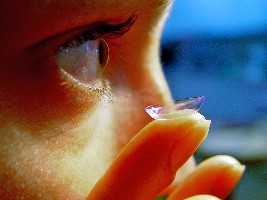Researchers at National Jewish Health in Denver, Colorado and the University of Texas Southwestern Medical Center in Dallas, Texas have discovered a new method to fight bacterial infections from contact lenses. The results were published online January 18 in the journal Investigative Ophthalmology and Visual Science (paid subscription required).
The problem arises from the interference of contact lenses with the eyes’ natural defenses. The bacteria Pseudomonas aeruginosa can cause infections leading to severe scarring and vision loss when they spread to the cornea. Eyes use blinking, among other methods, to remove bacterial organisms from the surface of the eye. Contact lenses, however, inhibit the effectiveness of blinking eyelids.
Thus, bacteria can adhere to the surface of the contact lens that sits against the eye. If those bacteria infect the corneal surface they can destroy the delicate corneal cells, which can lead to scarring and vision loss. The condition is known as microbial keratitis, and affects about two to four lens wearers per 10,000 each year.
Eye infections can be treated with antibiotics. However, it can be difficult to eliminate the bacteria on the contact lenses, especially when they form a biofilm. A biofilm is a matrix that harbors and encases communities of the organisms, making them harder to eradicate.
The researchers attacked that biofilm matrix. As the paper’s senior author Jerry Nick, a professor of medicine at National Jewish Health explains. “By breaking apart a molecular scaffolding that encases the organisms and makes them more difficult to eradicate,” says Nick, “we were able to significantly reduce bacterial infection of the cornea.”
The team had the benefit of earlier research that identified material making up the protective biofilm, namely remnants of dead white blood cells from the body’s immune system. The researchers used an enzyme called DNase that digests DNA, fortified with polyaspartic acid, to break up chemical bonds that support the biofilm.
The results show the treatment reduced biofilms on the contact lenses by 79 percent. The same treatment reduced infection of the cornea in an animal model by 41 percent. The found no evidence of harm caused by the treatments.
* * *


 RSS - Posts
RSS - Posts
You must be logged in to post a comment.